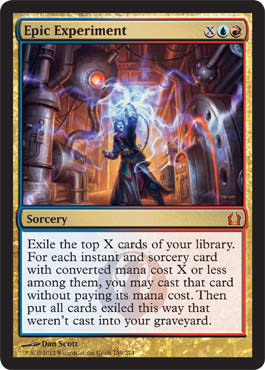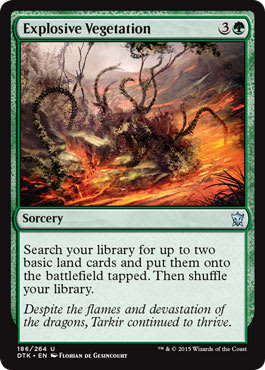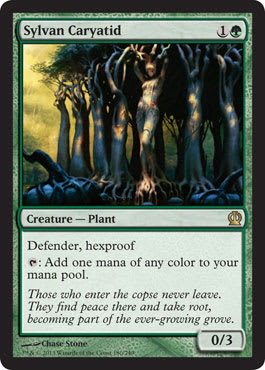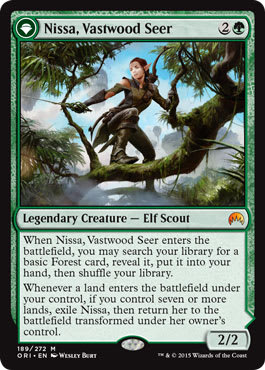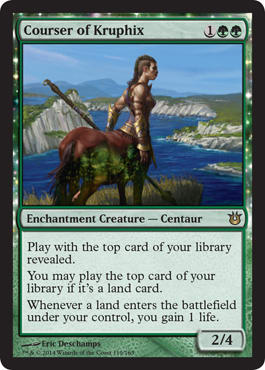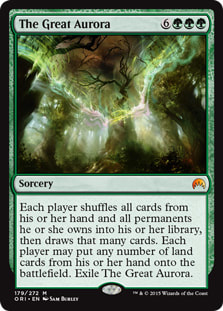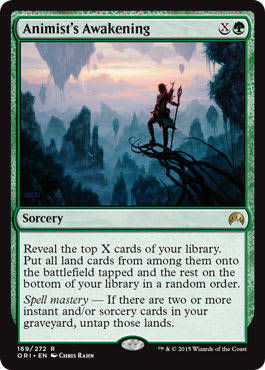In this experiment, we revisit the great waters of dread.
Almost three years ago, I engaged in The Dreadwater Experiment. Using Epic Experiment, Boundless Realms, and Dreadwaters, I sought to indulge in some casual Standard play to mill my opponents out. With Dreadwaters back in Magic Origins, I can’t help but revisit the card to see what I can come up with.
Explosive Start
Dreadwaters asks for a lot of lands. So to start, let’s take a look at the ramp options I settled on.
Explosive Vegetation — I would have loved to have had this three years ago. Putting two lands directly on the battlefield for one spell is very powerful, and Explosive Vegetation even lets us pick the lands we want (as long as they’re basic). Nissa's Expedition would be a reasonable stand-in if we didn’t have this option, but we do.
Sylvan Caryatid — Rampant Growth, or something like it, is an important option for ramp decks. Last time, we had Farseek, which could even fetch shock lands. Font of Fertility is an option here, but it actually costs 3 mana. Sure, we can virtually negate 1 mana of that cost by casting it on turn one, when we wouldn’t be casting anything else anyway, but we want to have time to play our tapped land Temple of Mystery. Sylvan Caryatid is like a Rampant Growth that can block. The downside, of course, is that it can die and isn’t actually a land (for Dreadwaters purposes), but being able to block should make up for that—and as we’ll see later, we may be able to transform it into a land.
Nissa's Pilgrimage — This one has received some attention for being a kind of upgraded Cultivate or Kodama's Reach. As is readily apparent, however, it only finds us Forests. That’s a pretty steep downside in a multicolored deck, but let’s just hope we’ll be able to find the Islands we need in other ways (such as by grabbing two with our Explosive Vegetation).
Nissa, Vastwood Seer — If Nissa's Pilgrimage is Cultivate, Nissa, Vastwood Seer is Borderland Ranger. Each is a variation of its predecessor with upsides—but with the downside of only being friendly with Forests. Also, Nissa doesn’t actually ramp us—she just ensures we’ll have a land to play. But making sure we have a land to play is important, and the upside she can give us is big. Not only does her first loyalty ability as Nissa, Sage Animist give us a lot of power, her ultimate provides an alternate—and very fun—win condition.
Courser of Kruphix — Like, Nissa, the Courser, just helps us hit our land drops. It also rewards us for them with life and helps us hold down the fort.
Dictate of Karametra — This doesn’t give us any lands for Dreadwaters purposes, but it does make the lands we’ve already brought out much more powerful. Also, it can virtually provide us extra lands in combination with the following card. (And don’t forget to cast this at the end of the opponent’s turn before “going off” in order to try to prevent the opponent from benefiting from the parallel upside.)
Animist's Awakening — This exciting X spell can find us a lot more lands. The more lands we have, the more we can find, and the spell mastery ability lets us chain big spells, especially when powered by Dictate of Karametra.
Great! Or . . . Or . . . Uh . . .
If Animist's Awakening is this iteration’s version of the previous iteration’s Boundless Realms, what’s our Epic Experiment analogue? When I saw The Great Aurora—with the lens of playing Dreadwaters of course—I couldn’t resist. What does The Great Aurora do for us?
First of all, it’s a kind of board reset. Assuming our opponent will have a more threatening battlefield position than we do, The Great Aurora can serve as a kind of Wrath of God. When we cast it, our opponent may end up with more lands or fewer, and may end up with more threats or fewer, but at least those threats aren’t on the battlefield anymore.
It’s also important to understand how the value of The Great Aurora works in terms of card advantage. It counts up all cards in hand and permanents on the battlefield and replaces them with new cards in hand, lands from which can be dropped onto the battlefield. Using The Great Aurora means we’re immediately down one card compared to our opponent because The Great Aurora itself isn’t replaced. However, cards like Nissa, Vastwood Seer, Nissa's Pilgrimage, Explosive Vegetation, Animist's Awakening, and even Courser of Kruphix can give us extra cards.
Imagine casting Explosive Vegetation before The Great Aurora. What was one card in our hand (to be replaced by one card with The Great Aurora) is now two cards on the battlefield (to be replaced by two cards with The Great Aurora). And in the same way Explosive Vegetation is one card that becomes two, so is Nissa. Nissa's Pilgrimage is one card that can become two or three. Courser of Kruphix is one card in our hand that becomes one card on the battlefield that can incrementally give us additional cards on the battlefield (by letting us play lands that we didn’t have to draw). And Animist's Awakening does the most work here, being one card that can become many.
Finally, consider that The Great Aurora doesn’t put the lands onto the battlefield tapped when it lets us drop them. That means we can potentially chain spells—or at least leave mana up during our opponent’s turn. While we may have had to shuffle away a Dictate of Karametra from the battlefield, if we redraw it with The Great Aurora, we can cast it at the end of our opponent’s subsequent turn.
A Sample Aurora
Let’s take a look at a sample sequence that’s definitely, complete, certainly not an instance of best-case-scenario mentality.
- Turn one: Temple of Mystery
- Turn two: Island; Sylvan Caryatid
- Turn three: Forest; Explosive Vegetation for Forest and Island
- Turn four: Forest; Dictate of Karametra; Explosive Vegetation for Forest and Island
- Turn five: Forest; Animist's Awakening for 16, hitting fifteen lands, which are untapped because of spell mastery; The Great Aurora, floating all excess mana and drawing three Dreadwaters and twenty-four lands among our twenty-seven or so cards; Dreadwaters three times for twenty-four cards milled each, for a total of seventy-two cards milled
Okay, so that exact sequence may be unlikely to happen. In case it doesn’t happen quite that quickly, we also have four Aetherspouts to hold off the beats. Note that while it looks like a bounce spell, it actually forces the opponent to redraw (or abandon) the creatures that are ’Spouted, so that generates more relative value for us when using The Great Aurora.
The Dreadwater Aurora ? Casual Standard | Andrew Wilson
- Creatures (10)
- 4 Courser of Kruphix
- 4 Sylvan Caryatid
- 2 Nissa, Vastwood Seer
- Spells (26)
- 4 Aetherspouts
- 1 Temporal Trespass
- 3 Nissa's Pilgrimage
- 3 The Great Aurora
- 4 Animist's Awakening
- 4 Dreadwaters
- 4 Explosive Vegetation
- 3 Dictate of Karametra
- Lands (24)
- 10 Forest
- 6 Island
- 4 Temple of Mystery
- 4 Yavimaya Coast
If you miss The Dreadwater Experiment, if you want to try something strange in Standard with The Great Aurora, or if you just like ramping, give this deck a try.
Andrew Wilson
fissionessence at hotmail dot com















